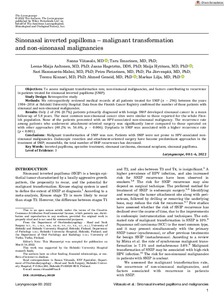Sinonasal inverted papilloma: malignant transformation and non-sinonasal malignancies
Viitasalo Sanna; Ilmarinen Taru; Aaltonen Leena-Maija; Hagström Jaana; Hytönen Maija; Hammarén-Malmi Sari; Pietarinen Petra; Järvenpää Pia; Kinnari Teemu; Geneid Ahmed; Lilja Markus
https://urn.fi/URN:NBN:fi-fe2022081154698
Tiivistelmä
Objectives: To assess malignant transformation rate, non-sinonasal malignancies, and factors contributing to recurrence in patients treated for sinonasal inverted papilloma (SNIP).
Study design: Retrospective study.
Methods: We retrospectively reviewed medical records of all patients treated for SNIP (n = 296) between the years 1984-2014 at Helsinki University Hospital. Data from the Finnish Cancer Registry confirmed the number of those patients with sinonasal and non-sinonasal malignancies.
Results: Only 2 of 296 (0.7%) patients primarily diagnosed with benign SNIP developed sinonasal cancer in a mean follow-up of 5.8 years. The most common non-sinonasal cancer sites were similar to those reported for the whole Finnish population. None of the patients presented with an HPV-associated non-sinonasal malignancy. The recurrence rate among patients who underwent attachment-oriented surgery was significantly lower compared to those operated on with other approaches (40.2% vs. 56.6%, p = 0.006). Dysplasia in SNIP was associated with a higher recurrence rate (p < 0.001).
Conclusions: Malignant transformation of SNIP was rare. Patients with SNIP were not prone to HPV-associated non-sinonasal malignancies. Endoscopic resection and attachment-oriented surgery have become predominant approaches in the treatment of SNIP; meanwhile, the total number of SNIP recurrences has decreased.
Kokoelmat
- Rinnakkaistallenteet [27094]
